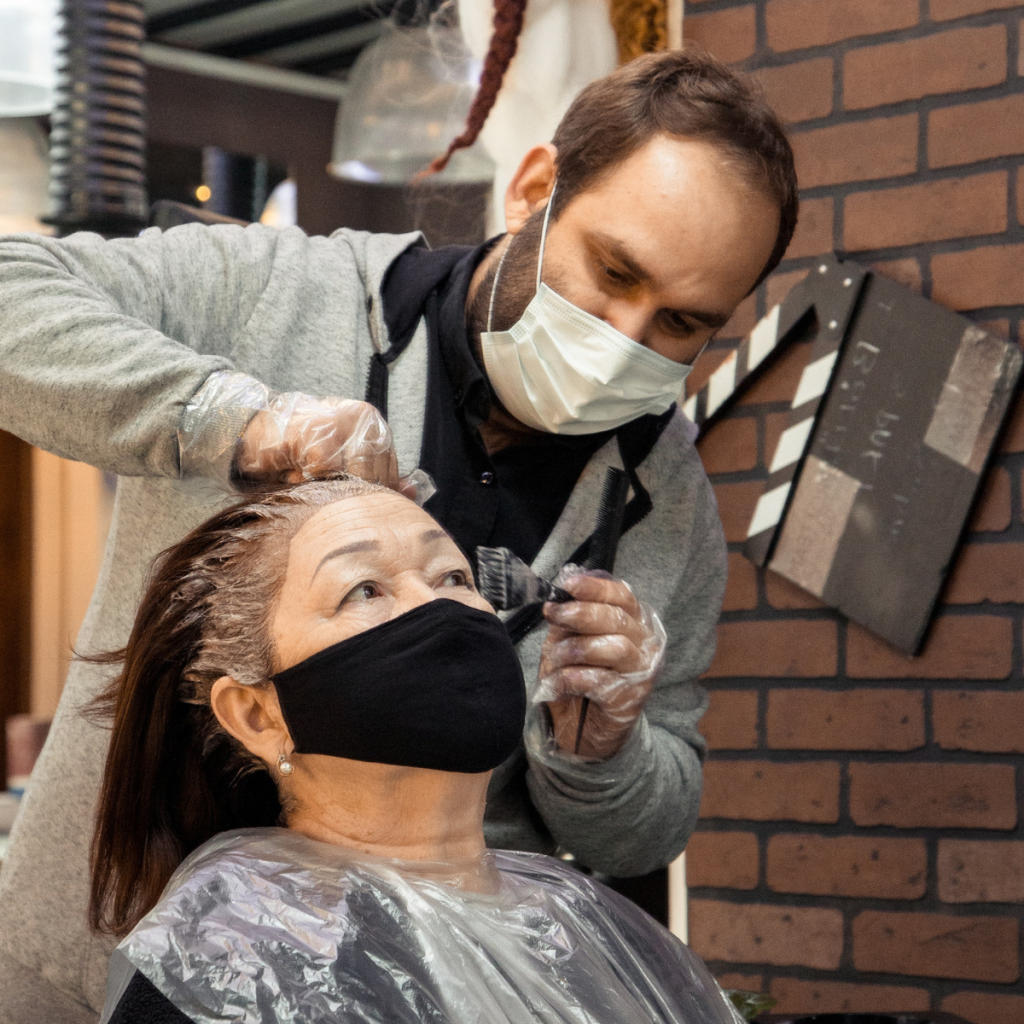Discover the benefits of hair masks and deep conditioners in preventing split ends.
How Hair Masks and Deep Conditioners Help Prevent Split Ends
Enter the hair mask, the superhero of hair care. A hair mask is a deep conditioning treatment that penetrates the hair shaft to provide intense hydration and nourishment. It’s like a spa day for your strands!
Split ends can be a major bummer for anyone striving for luscious locks. They not only make our hair look frizzy and damaged, but they can also hinder hair growth. Thankfully, there are ways to combat these pesky split ends, and two of the most effective solutions are hair masks and deep conditioners. Let’s dive into the magic of these hair care heroes and discover how they can help prevent split ends.

Understanding Split Ends: Causes and Effects
Before we delve into the world of hair masks and deep conditioners, it’s important to understand what split ends actually are. Split ends are the result of the hair shaft splitting into two or more strands due to damage. This damage can be caused by a variety of factors, including excessive heat styling, chemical treatments, harsh brushing, or even just everyday wear and tear on the hair.
So, what are the effects of split ends? Aside from their less-than-ideal appearance, split ends can lead to further breakage and stunted hair growth. Not exactly the hair goals we’re aiming for, right? That’s where hair masks and deep conditioners come to our rescue.
What are Split Ends?
Split ends, also known as trichoptilosis, occur when the protective outer layer of the hair, known as the cuticle, becomes damaged or worn away. This exposes the inner layers of the hair, making it more prone to breakage and splitting.
But let’s dive a little deeper into the science behind split ends. The hair shaft is made up of three layers: the cuticle, the cortex, and the medulla. The cuticle is the outermost layer and acts as a protective barrier for the inner layers. When the cuticle becomes damaged, it loses its ability to protect the hair, leading to split ends.
Imagine the hair shaft as a sturdy rope. When the cuticle is intact and healthy, it wraps tightly around the inner layers, keeping them protected and preventing breakage. However, when the cuticle is damaged, it starts to fray, much like the end of a rope. This fraying causes the hair strand to split into two or more strands, resulting in split ends.
Factors Contributing to Split Ends
There are several factors that can contribute to the formation of split ends. Excessive heat from styling tools like hair dryers and curling irons can weaken the hair and cause it to split. The high temperatures strip the hair of its natural moisture, leaving it dry and brittle. This makes the hair more susceptible to damage and splitting.
Using harsh chemical treatments, such as perms or relaxers, can also damage the hair structure and lead to split ends. These treatments often involve the use of strong chemicals that break down the hair’s protein bonds, making it weaker and more prone to breakage.
Even everyday activities like brushing or towel-drying wet hair can cause split ends if done too roughly or vigorously. When the hair is wet, it is more fragile and prone to damage. So, it’s important to handle wet hair with care, using a wide-toothed comb or a gentle brush to detangle it.
And if that’s not enough, environmental factors like sun exposure, pollution, and humidity can also take a toll on our hair, making it more prone to splitting. The harmful UV rays from the sun can weaken the hair’s structure, while pollution and humidity can cause the hair to become dry and frizzy, increasing the likelihood of split ends.
The Impact of Split Ends on Hair Health
Split ends are not just a cosmetic concern; they can actually have a negative impact on the overall health of our hair. When the hair shaft splits, it becomes weaker and more susceptible to further damage. This can lead to breakage, frizziness, and an overall dull appearance.
Furthermore, split ends can hinder hair growth. When the hair is constantly breaking due to split ends, it becomes difficult for it to grow longer. The ends of the hair become thinner and weaker, making it more prone to breakage and preventing it from reaching its full potential in terms of length.
So, if you’re aiming for that Rapunzel-worthy mane, it’s crucial to keep those split ends at bay. Regular trims, deep conditioning treatments, and gentle hair care practices can help prevent and minimize the occurrence of split ends, allowing your hair to grow healthy and strong.
The Role of Hair Masks in Preventing Split Ends
What is a Hair Mask?
A hair mask is a concentrated treatment designed to target specific hair concerns, such as split ends. Unlike regular conditioners, which are meant to be used on a daily basis, hair masks are usually used once or twice a week for a more intensive treatment.
A good hair mask will contain ingredients that help repair and strengthen the hair, such as proteins, vitamins, and essential oils. These powerhouse ingredients work together to nourish the hair from within and seal the cuticle, preventing further damage and split ends.
Key Ingredients in Hair Masks for Split Ends
When it comes to fighting split ends, there are a few key ingredients you’ll want to look out for in your hair mask. One of these is keratin, a protein that helps strengthen the hair and prevent breakage. Another superstar ingredient is argan oil, which is rich in antioxidants and fatty acids that nourish and repair damaged hair.
Other beneficial ingredients for split ends include shea butter, which provides deep hydration, and vitamin E, which helps protect the hair from environmental damage. So, keep an eye out for these hair-loving ingredients when choosing your hair mask.
How to Apply a Hair Mask for Maximum Benefits
Now that you have your trusty hair mask in hand, it’s time to put it to work. Start by shampooing your hair as usual to remove any buildup or dirt. Then, take a generous amount of the hair mask and apply it to your damp hair, focusing on the ends where split ends tend to occur.
Gently massage the mask into your strands, making sure to distribute it evenly from roots to tips. Leave the mask on for the recommended amount of time (usually around 10-20 minutes) to allow the ingredients to work their magic.
While you wait, why not indulge in a little self-care? Put on your favorite face mask, sip some herbal tea, or catch up on your favorite show. Once the timer goes off, rinse out the hair mask thoroughly with warm water. Voila! Your hair is now treated to some serious split-end-fighting goodness.
Deep Conditioners: A Solution to Split Ends
Hair masks aren’t the only players in the split-end prevention game. Deep conditioners also have a significant role to play in maintaining healthy, split-end-free hair. Just like hair masks, deep conditioners provide intense hydration and nourishment to the hair, but they can be used more frequently and are often lighter in texture.
Understanding Deep Conditioners
Deep conditioners are designed to penetrate the hair shaft and deliver moisture and nutrients. They contain ingredients that help improve the hair’s elasticity, strengthen the strands, and promote overall hair health.
Unlike hair masks, which are typically left on for a longer period of time, deep conditioners are usually applied after shampooing and left on for a shorter duration, usually around 3-5 minutes. This makes them perfect for those times when you need a quick pick-me-up for your hair.
How Deep Conditioners Work to Prevent Split Ends
Deep conditioners work their magic by replenishing moisture and repairing damaged hair. They contain ingredients like glycerin, which attracts and retains moisture, and panthenol, which helps improve the hair’s elasticity and strength.
By infusing the hair with these vital nutrients, deep conditioners help seal the cuticle and prevent moisture loss, which in turn reduces the likelihood of split ends. Regular use of deep conditioners can strengthen the hair and make it more resistant to damage, resulting in healthier, happier strands.
Choosing the Right Deep Conditioner for Your Hair Type
With a wide array of deep conditioners available on the market, it’s important to choose one that suits your hair type and specific needs. If you have fine or oily hair, opt for a lightweight, non-greasy formula that won’t weigh your hair down.
On the other hand, if you have dry or damaged hair, go for a richer, more nourishing deep conditioner that will provide extra hydration and repair. Look for ingredients like avocado oil, coconut oil, or shea butter, which are known for their moisturizing and restorative properties.
Comparing Hair Masks and Deep Conditioners
Now that we’ve explored the individual powers of hair masks and deep conditioners, let’s compare them side by side. While both products serve the common goal of preventing split ends, they do have some differences.

Similarities and Differences
Both hair masks and deep conditioners provide intense hydration and nourishment to the hair, helping to prevent split ends and promote overall hair health. However, hair masks are usually more potent and are used less frequently, making them ideal for a more intensive treatment.
Deep conditioners, on the other hand, can be used more regularly as a quick pick-me-up for the hair. They are often lighter in texture and are great for maintaining the overall health and strength of the hair.
In terms of application, hair masks are typically left on for a longer period of time, allowing the ingredients to penetrate deeper into the hair shaft. Deep conditioners, on the other hand, are applied after shampooing and are rinsed out after a shorter duration.
Ultimately, the choice between a hair mask and a deep conditioner depends on the specific needs of your hair and your personal preferences. Some people may find that using both products in their hair care routine yields the best results.
When to Use a Hair Mask vs a Deep Conditioner
So, when should you reach for a hair mask, and when should you opt for a deep conditioner? Here’s a simple rule of thumb: if your hair is in need of a little extra TLC and repair, go for a hair mask. Use it once or twice a week to deeply nourish and strengthen your hair, helping to prevent split ends.
If, on the other hand, you’re looking for a regular maintenance treatment to keep your hair healthy and split-end-free, a deep conditioner is your go-to. Use it after every shampoo to replenish moisture and maintain the overall health of your hair.
Remember, prevention is always better than a cure when it comes to split ends. By incorporating hair masks or deep conditioners into your hair care routine, you can proactively protect your hair from damage and keep those split ends at bay.
So, let’s bid farewell to frizzy, damaged strands and say hello to luxuriously healthy hair. With the power of hair masks and deep conditioners, split ends don’t stand a chance!





